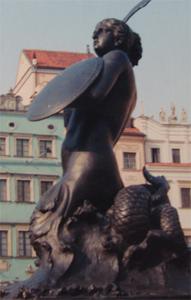

With sword and shield, the Warsaw Mermaid guards the Old Town district.
This fall for the first time, my husband and I were not constrained by an academic schedule and were, therefore, able to plan a journey abroad. It was my husband's turn to choose the destination. I was hoping for autumn in Tuscany; he chose Poland.
While I expected old world charm and new world intellectual dialogue, I had not thought much about the Polish art scene - beyond Chopin, quaint folk art, and beautiful amber from the Baltic Sea. Silly me - I should have known there would be arts all around.
Because at least 90 percent of Warsaw was destroyed in World War II, the city is practically all new, but other than the hundred or so skyscrapers, it does not look new. Visitors are immediately struck by the combination of ambitious urban architecture in the form of daring high-rise buildings of glass and steel and the world's most amazing reconstruction of centuries-old historic properties. The blend of ultra new and faux old is unlike anywhere else in the world. Guides proudly point to block after block of Medieval and Renaissance architecture and say, "It's all fake and we are so proud of it. We (the citizens) did it. Even under the communists, we were able to tax ourselves and rebuild our beautiful old town."
The most outstanding example of this phenomenal rebuilding of the old is the Royal Castle, a magnificent Baroque structure and the civic pride of modern Warsaw. Destroyed by the Nazis, the Castle was the first major undertaking to be reconstructed from a pile of rubble between 1971 and 1984. Inside, the rooms are typical royal rooms with gilded furniture, tapestries, and many portraits of royalty.
What kept me going from room to room and floor to floor was the special exhibit on the top floor of 150 pieces of silver and other metal works by gifted craftsmen from the 16th to 19th centuries. The whimsical dishes and goblets formed in the shapes of animals, ships, and windmills captivated me. Some were combined with other objects, such as conch shells and semiprecious stones.
The gallery scene in Warsaw appears to be surprisingly vital, considering that private galleries have only been an option since 1990. My impression from a half day of gallery hopping is that Polish painting, in particular, is strong. A weaving exhibit caught my attention at Elector Gallery and motivated me to tour the Royal Weaving Workshop that dates to 1765. In 1801 the Frenchman Jacquard invented a mechanical loom for the workshop that used punch cards to determine the pattern. To change patterns, the loom operator changes cards. We saw a fascinating demonstration by a young woman using an 1819 punch-card pattern to weave a "wall carpet" of linen and wool.
At the Zacheta National Gallery of Art, I was taken aback by a highly publicized exhibit called "Black Alphabet:conTEXTS of Contemporary African-American Art." A collaborative project of the Polish National Gallery and The Studio Museum in Harlem, the exhibit surveys the leading edge in work by African American artists. Some I readily recognized, such as Carrie Mae Weems who had a solo exhibit at Roanoke College last year. Others were vaguely familiar, while most were new to me. The range was representative of the American contemporary art scene, especially with regard to media installation, video, and found objects. The themes of violence and depravation as well as class and racial issues were painful. The celebration of black music and literature was a strong motif in this complex project.
The catalogue for "Black Alphabet" pays special tribute to one of our area's former neighbors: His Excellence Mr. Victor Ashe, the U.S. Ambassador to Poland, who was for many years the mayor of Knoxville, Tennessee. The Ambassador was so kind in inviting John Gaines, former mayor of Bristol, Tennessee, and my husband and me to the ambassador's residence. There we had an artistic surprise!
The Ambassador and his wife have chosen to decorate the residence with works of art by East Tennessee luminaries: glass artists Tommie Rush and Richard Jolley, sculptor and painter Jim Gray, fiber artist Betsy Wooden, and self-taught Smoky Mountains painter Ron Williams. Prominent in the house is an antique Tennessee quilt from Mrs. Ashe's family.
Public art in Warsaw is varied. Sculptures of a mermaid, the traditional symbol of Warsaw, are popular. (Legend attributes the city's name to a mermaid who asked lovers, Wars and Zawa, to found a city and call it Warszawa.) The mermaid is typically depicted with sword and shield, protecting her city on the shores of the Vistula River. Surviving from the 17th century is a bronze statue of an early ruler sitting atop a 72-foot-high column. In 1989, a monumental sculpture honoring the 1944 Warsaw Uprising was installed. In a major city park, formerly a Royal Garden, an impressive Chopin Memorial honoring Poland's best known composer (Frederic Chopin, 1810-49), was unveiled in 1929; destroyed under the Nazis; and after the war, recast and installed.
Poland is a complicated land and its people filled with contradictions and challenges, especially as it reconciles church and state issues, the past symbolized by Auschwitz, and the future dominated by the challenges of democracy and a free market economy. Most inspiring is the evident vitality of art as a reflector and leader in every segment of society. Next month, I will share my impressions of Krakow, Poland, a UNESCO World Heritage Site and a repository of great art. Meanwhile, I extend heartfelt wishes for a healthy, art-filled holiday season.